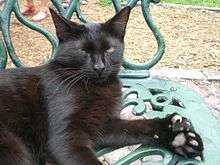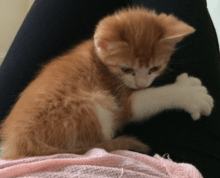Polydactyl cat

A polydactyl cat is a cat with a congenital physical anomaly called polydactyly (or polydactylism, also known as hyperdactyly), that causes the cat to be born with more than the usual number of toes on one or more of its paws. Cats with this genetically inherited trait are most commonly found along the East Coast of North America (in the United States and Canada) and in South West England and Wales.
Occurrence
The true polydactyly is a congenital abnormality, genetically inherited as an autosomal dominant trait of the ZRS cis element of the Pd gene with incomplete penetrance.[1]

Normal cats have a total of 18 toes, with five toes on each front paw and four toes on each hind paw; polydactyl cats may have as many as eight digits on their front and/or hind paws. Jake, a Canadian polydactyl cat with 28 toes, was recognised by Guinness World Records as having the highest number of toes on a cat.[2] Various combinations of anywhere from four to seven toes per paw are common.[3] Polydactyly is most commonly found on the front paws only, it is rare for a cat to have polydactyl hind paws only, and polydactyly of all four paws is even less common.
The nickname "double-pawed cat" is a misnomer since there is a specific double paw condition, although this condition may be interrelated with polydactyly.[4]
Feline radial hypoplasia (see squitten) is a mimic of polydactyly and is considered a severe condition. Radial hypoplasia may cause the formation of extra jointed toes, but it is not a result of the gene normally associated with polydactyls. It thus does not cause the "mitten cat" or "thumb cat" condition where the extra toes occur separated from the normal ones just like a dewclaw, usually associated with an additional pad which makes them look like an underdeveloped foot sticking out near the base of the normal toes. Rather, radial hypoplasia-related extra toes are immediately adjacent to the normal ones, giving the cat overly large, flat feet — colloquially known as "patty feet" or "hamburger feet". Though this looks less serious than true polydactyly (as the feet appear "normal" apart from having one or two extra toes), breeding such cats will eventually result in severely disabled offspring. Cats used in polydactyl breeding programs can be screened by x-ray for indicators of radial hypoplasia, and cats suspected to have radial hypoplasia should not be used for breeding.
History and folklore
The condition seems to be most commonly found in cats along the East Coast of North America (in the United States and Canada) and in South West England, Wales and Kingston-upon-Hull. Polydactyl cats have been extremely popular as ship's cats. Although there is some controversy over whether the most common variant of the trait originated as a mutation in New England or was brought there from Britain, there seems to be agreement that it spread widely as a result of cats carried on ships originating in Boston, Massachusetts, and the prevalence of polydactyly among the cat population of various ports correlates with the dates when they first established trade with Boston.[4][5] Contributing to the spread of polydactyl cats by this means, sailors were long known to value polydactyl cats especially for their extraordinary climbing and hunting abilities as an aid in controlling shipboard rodents. Some sailors also considered them to be extremely good luck when at sea.
Genetic work studying the DNA basis of the condition however indicates that many different mutations can all lead to polydactyly[1] and since samples from the UK and USA were shown to possess different mutations it seems likely that these cats have originated multiple times independently, rather than spreading from a single origin.
Nobel Prize-winning author Ernest Hemingway was a famous aficionado of polydactyl cats, after being first given a six-toed cat by a ship's captain. Upon Hemingway's death in 1961, his former home in Key West, Florida, became a museum and a home for his cats, and it currently houses approximately fifty descendants of his cats (about half of which are polydactyl). Because of his love for these animals, polydactyl cats are sometimes referred to as "Hemingway Cats".
Some sources state that these cats are rare in Europe because they were killed as witches' familiars,[5] but other sources indicate that they are quite common in southern Britain.[4]
Naming
Nicknames for polydactyl cats include "conch cats", "boxing cats", "mitten cats", "mitten-foot cats", "snowshoe cats", "thumb cats", "six-fingered cats", "Cardi-cats", and "Hemingway cats". Two specific breeds recognized by some but not all cat fancier clubs are the American Polydactyl and Maine Coon Polydactyl, and named regional populations include the Boston thumb cat, Cardi-cat, Ithacat, and Vermont snowshoe cat.
Breeding
American Polydactyl cats are bred as a specific cat breed, with specific physical and behavioral characteristics in addition to extra digits.[6]
The American Polydactyl is not to be confused with the pedigree Maine Coon polydactyl. The polydactyl form of the Maine Coon is being reinstated by some breeders.[7]
A particular strain of polydactyl cats native to Ithaca, New York is known as the Ithacat. Polydactyls are very common in the Cardigan area of Wales, where they are known as "Cardi-cats."
PolyTrak Database of polydactyl Maine Coons

The database PolyTrak comprises 1800 Maine Coons in total (as of July 2014). Out of them about 1200 are polydactyl.[8] The PolyTrak database service is a repository of information for the Maine Coon polydactyl cat. Details on numbers of toes are given as well as of catteries, sires and dames. Physiological characteristics of each polydactyl individual are also stored. There is no medical injury mentioned of any polydactyl Maine Coon individual. Thus PolyTrak could help to confirm on a broad empirical base, that the polydactyl Maine Coon (Hemingway mutant) has no negative health effects at all.
Genetic causes



In the case of preaxial polydactyly of the Maine Coon cat (Hemingway mutant) a mutation of the cis-regulatory element ZRS (ZPA regulator sequence) is associated. ZRS is a noncoding element, 800.000 basepairs remote to the target gene Shh. An ectopic expression of Shh is seen on the anterior side of the limb. Normally Shh is expressed in an organiser region, called the zone of polarizing activity (ZPA) on the posterior limb side. From there it diffuses anteriorly, laterally to the growth direction of the limb. In the mutant mirroring smaller ectopic expression in a new organiser region is seen on the posterior side of the limb. This ectopic expression causes cell proliferation delivering the raw material for one or more new digits.[9][1][10]
In addition to the study of genetic causes of polydactyly limb patterning models are used to simulate the congenital disorder at the limb, being able to explain the development paths of polydactyly.
Biased polyphenism of a spontaneous complex variation
Polydactyly is a spontaneous complex phenotypic variation, developed in one generation. In the concrete preaxial form of the Hemingway mutant the variation is induced by a single point mutation in a noncoding cis-regulatory element for Shh. In an extensive phenotypic variation like this, one or more complete digits at each single limb are developed including nerves, blood vessels, muscles and ligaments. The physiology of the digits can be perfect. This complex phenotypic result cannot be explained by the mutation alone. The mutation can only induce the variation. In the consequence of the mutation thousands of events, each different from the wildtype, occur on different organisation layers, i.e. expression changes of other genes, cell-cell signal exchange, cell differentiation, cell and tissue growth. The summarized small random changes on all layers build the raw material and the process steps for the generation of the plastic variation.[3] The mentioned form of polydactyly of the Hemingway mutant shows a biased variation. In a recent empirical study first the number of extra toes of 375 mutant Maine Coon cats were variable (polyphenism) and second, the number of extra toes followed a discontinuous statistical distribution. They were not equally distributed as one might expect of an identical single point mutation. The example demonstrates, that the variation is not explained completely by the mutation alone.[3] The Maine Coon (wildtype: 18 toes) in some cases exhibits polydactyly with 18 toes, were the first toe at the forehand is elongated forming a three phalangeal thumb. More often 20 toes appear, and in diminishing order we see 22, 24 or 26 toes per individual. Also odd numbers of toes are seen.

References
- 1 2 3 Lettice LA, Hill AE, Devenney PS, Hill RE (2008). "Point mutations in a distant sonic hedgehog cis-regulator generate a variable regulatory output responsible for preaxial polydactyly". Human Molecular Genetics. 17 (7): 978–85. doi:10.1093/hmg/ddm370. PMID 18156157.
- ↑ "Most toes on a cat". Retrieved 2015-06-29.
- 1 2 3 Lange, Axel; Nemeschkal, Hans L.; Müller, Gerd B. (2013). "Biased Polyphenism in Polydactylous Cats Carrying a Single Point Mutation: The Hemingway Model for Digit Novelty". Evolutionary Biology. 41 (2): 262–75. doi:10.1007/s11692-013-9267-y.
- 1 2 3 "Polydactyl Cats (Part 1)". Retrieved 2007-01-20.
- 1 2 "Is it true many New England cats have extra paws because Boston ships' captains considered them lucky? Or may it be true that they were better at catching mice than normal cats?". The Straight Dope. 1999-06-29. Retrieved 2007-01-20.
- ↑ "American Polydactyl". Archived from the original on January 17, 2007. Retrieved 2007-01-20.
- ↑ Kus, Beth E. "The History of the Polydactyl Maine Coon". Retrieved 2008-02-12.
- ↑ PolyTrak database
- ↑ Lettice LA, Heaney SJ, Purdie LA, Li L, de Beer P, Oostra BA, Goode D, Elgar G, Hill RE, de Graaff E (2003). "A long-range Shh enhancer regulates expression in the developing limb and fin and is associated with preaxial polydactyly". Human Molecular Genetics. 12 (14): 1725–35. doi:10.1093/hmg/ddg180. PMID 12837695.
- ↑ Lettice LA, Williamson I, Wiltshire JH, Peluso S, Devenney PS, Hill AE, Essafi A, Hagman J, Mort R, Grimes G, DeAngelis CL, Hill RE (2012). "Opposing functions of the ETS factor family define Shh spatial expression in limb buds and underlie polydactyly". Developmental Cell. 22 (2): 459–67. doi:10.1016/j.devcel.2011.12.010. PMC 3314984
 . PMID 22340503.
. PMID 22340503.
Further reading
- Chapman, V. A.; Zeiner, Fred N. (1961). "The anatomy of polydactylism in cats with observations on genetic control". The Anatomical Record. 141: 205–17. doi:10.1002/ar.1091410305. PMID 13878202.
- Danforth CH (1947). "Heredity of polydactyly in the cat". The Journal of Heredity. 38 (4): 107–12. PMID 20242531.
- Danforth, C. H. (1947). "Morphology of the feet in polydactyl cats". American Journal of Anatomy. 80 (2): 143–71. doi:10.1002/aja.1000800202. PMID 20286212.
- Jude, A. C. (1955). Cat genetics. Fond du Lac: All-Pets Books. OCLC 1572542.
- Lockwood, Samuel, From American Naturalist "Malformations", polydactyl cats - Popular Science Monthly January 1974 Page 383
- Robinson, Roy (1977). Genetics for Cat Breeders (2nd ed.). Elsevier. ISBN 978-0-08-021209-8.
- Sis RF, Getty R (1968). "Polydactylism in cats". Veterinary Medicine, Small Animal Clinician. 63 (10): 948–51. PMID 5188319.
- Todd NB (1966). "The independent assortment of dominant white and polydactyly in the cat". The Journal of Heredity. 57 (1): 17–8. PMID 5917255.
- Vella, Carolyn M.; Shelton, Lorraine M.; McGonagle, John J.; Stanglein, Terry W. (1999). Robinson's Genetics for Cat Breeders and Veterinarians (4th ed.). Oxford: Butterworth-Heinemann. ISBN 978-0-7506-4069-5.
- Wenthe, M; Lazarz, B (1995). "Ein Fall von atavistischer Polydaktylie an der Hinterextremität des Hauskatze" [A case of atavistic polydactyly at the hind limb of a cat]. Kleintierpraxis (in German). 40 (8): 617–9.
- Wittmann, F (1992). "Polydactylism in a Cat". Der Praktische Tierarzt. 73 (8): 709.
External links
| Wikimedia Commons has media related to Polydactyl cats. |
- Hemingway Home Museum, Key West Florida, cats webpage
- Article on polydactylism in cats in New England
- Images of polydactyl cats
- PolyTrak: Maine Coon Polydactyl Tracking Database and Resource
- Owner's appeal over cat's 26 toes